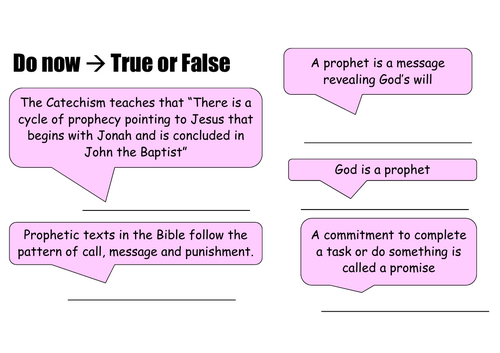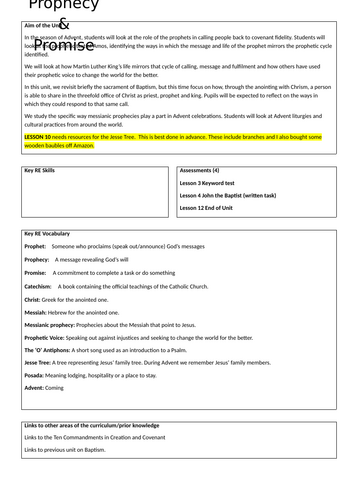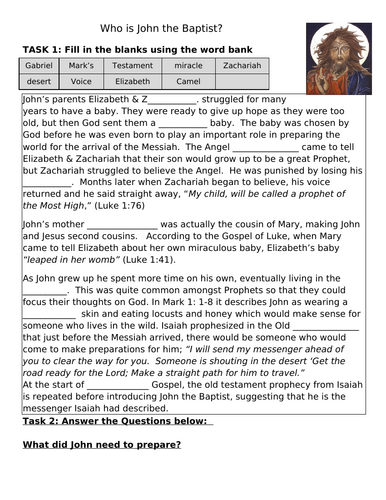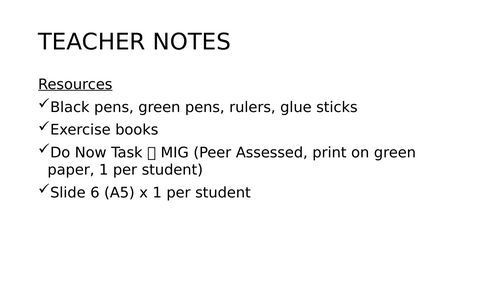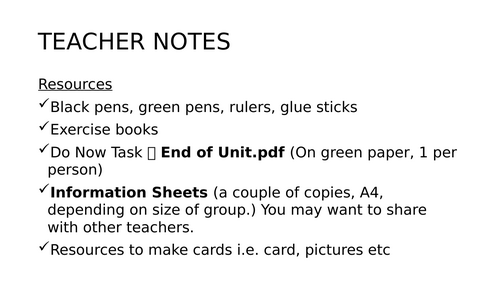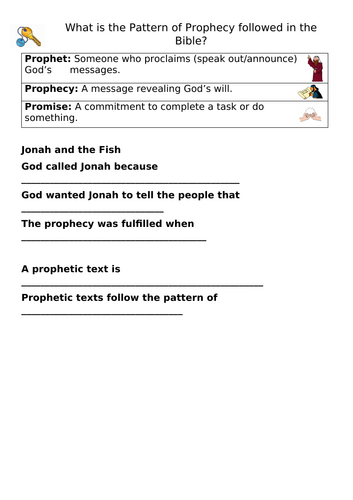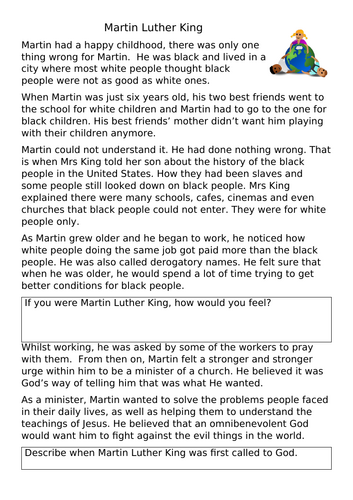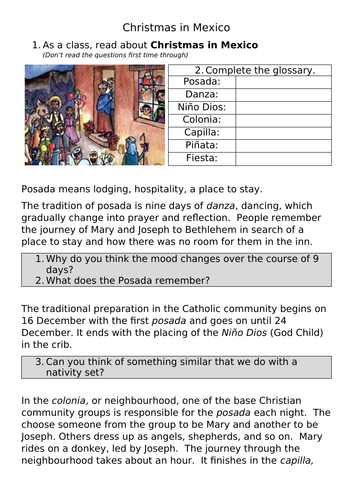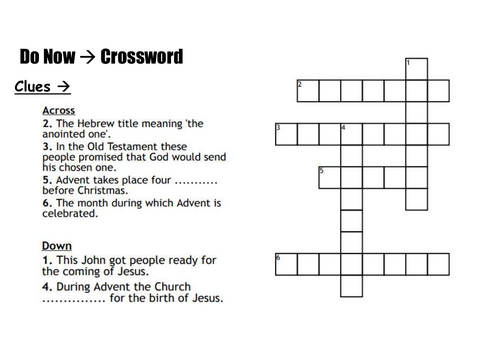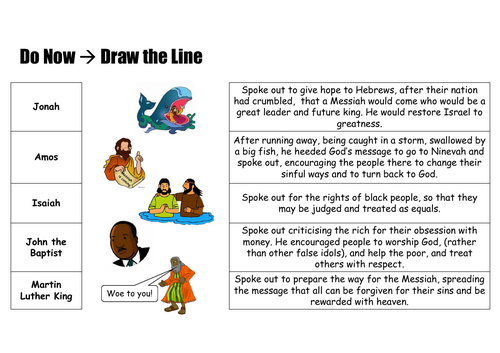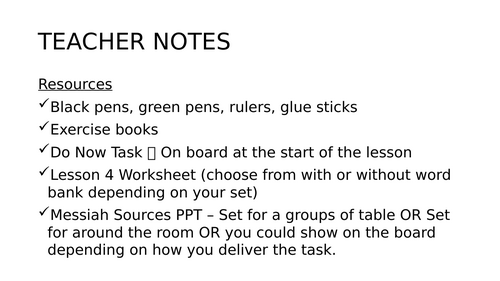
47Uploads
10k+Views
12k+Downloads
Religious education

Interpretations of Genesis
A lesson that I use with year 7 as part of my Genesis Scheme of Work. The aim is to recap the 6 day creation story (done in previous lesson). Get students to think about the difference between a literal truth and a metaphorical truth. Then we look at how different groups of Christians (Liberal, Conservative and Catholic) and how they interpret the Bible and Genesis 1. Although I use this with year 7, this could be used up to GCSE level with little adaptation.
Included - PPT to guide you through the lesson that includes tasks, starter, discussions. There is additional tasks if you have time.
Other Lessons in this scheme of work can be found on TES.
Genesis 1- 6 Days of Creation
2. Interpretations of Genesis THIS LESSON
The Garden of Eden
The Fall of Adam and Eve
Noah’s Ark
The Covenant with Abraham
Moses
With more lessons to follow

8.2 Prophecy and Promise: Why is the prophet Amos called by God? (Lesson 2)
Lesson to fit the new Religious Education Curriculum Directory “To know you more clearly”
**** 8.2 Prophecy and Promise****
This lesson focuses on:
Why was Amos calling people back to God?
What themes emerge during this prophetic text?
This is lesson 2 of the following scheme of work, which contains 12 lessons, although some lessons would span 2 hours.
Whole Scheme of work: £38.70 – 10% Discount
Lesson 1: What is the pattern of prophecy followed in the Bible? £4.00
Lesson 2: Why is the prophet Amos called by God? FREE
Lesson 3: Do the cries of Amos have any relevance today? £3.50
Lesson 4: How is the pattern of prophecy concluded in John the Baptist? £3.50
Lesson 5: Why do the prophetic texts point to Christ? £4.00
Lesson 6: How does Baptism allow us to share in Christ’s threefold office of priest, prophet and king? £4.00
Lesson 7: Martin Luther King £4.00
Lesson 8: Can you only speak with a prophetic voice if you are Christian? £4.00
Lesson 9: How are the prophetic texts reflected during Advent? £4.00
Lesson 10: Creating a Jesse Tree £4.50
Lesson 11: Advent Traditions £4.00
Lesson 12: End of Unit/Amnesty International Write for Rights. £3.50

Year 8 Prophecy and Promise Scheme of Learning.
12-15 lessons to fit the new Religious Education Curriculum Directory “To know you more clearly”
This scheme of learning was planned before the text books became available so might look quite different from any of the text books.
My resources for each lesson are available separately.

NEW EDEXCEL GCSE 60 Catholic Christianity Keyword Revision Cards (15 for each topic)
This revision resource can be used in class or can be given to students to make into revision cards.
Sets of cards can be printed on different coloured card, cut out and stuck back-to-back with keyword one side, definition the other.
Alternative if you like to play ‘I have the answer’ with a class you make these cards so that a student reads out the keyword (or definition depending on how you like to play) and another student responds if they think they have the definition on a different card - this takes a little planning to ensure that you choose a path through the keywords that covers all but its good fun.

GCSE Judaism - The Mitzvot
This lesson looks at the nature and importance of the Mitzvot and the relationship between the Mitzvot and Free-will. Main task is a rotation task. Students use the relevant information to fill in the boxes on their worksheet.
Lesson includes a ppt, activity, worksheet, starter and homework.

8.2 Prophecy and Promise: How is the pattern of prophecy concluded in John the Baptist? (Lesson 4)
Lesson to fit the new Religious Education Curriculum Directory “To know you more clearly”
**** 8.2 Prophecy and Promise****
This lesson focuses on:
Revise the pattern of prophecy and the common themes that emerge during prophetic texts?
Who is John the Baptist?
How is the pattern of prophecy concluded in John the Baptist?
This is lesson 4 of the following scheme of work, which contains 12 lessons, although some lessons would span 2 hours. (This curriculum was designed before the text book was out but covers the directory requirements)
Whole Scheme of work: £38.70 – 10% Discount
Lesson 1: What is the pattern of prophecy followed in the Bible? £4.00
Lesson 2: Why is the prophet Amos called by God? FREE
Lesson 3: Do the cries of Amos have any relevance today? £3.50
Lesson 4: How is the pattern of prophecy concluded in John the Baptist? £3.50
Lesson 5: Why do the prophetic texts point to Christ? £4.00
Lesson 6: How does Baptism allow us to share in Christ’s threefold office of priest, prophet and king? £4.00
Lesson 7: Martin Luther King £4.00
Lesson 8: Can you only speak with a prophetic voice if you are Christian? £4.00
Lesson 9: How are the prophetic texts reflected during Advent? £4.00
Lesson 10: Creating a Jesse Tree £4.50
Lesson 11: Advent Traditions £4.00
Lesson 12: End of Unit/Amnesty International Write for Rights. £3.50

8.2 Prophecy and Promise: Do the cries of Amos have any relevance today? (Lesson 3)
Lesson to fit the new Religious Education Curriculum Directory “To know you more clearly”
**** 8.2 Prophecy and Promise****
This lesson focuses on:
Do the cries of Amos have any relevance today?
What can people do to protect those who face injustices?
This is lesson 3 of the following scheme of work, which contains 12 lessons, although some lessons would span 2 hours. (This curriculum was designed before the text book was out but covers the directory requirements)
Whole Scheme of work: £38.70 – 10% Discount
Lesson 1: What is the pattern of prophecy followed in the Bible? £4.00
Lesson 2: Why is the prophet Amos called by God? FREE
Lesson 3: Do the cries of Amos have any relevance today? £3.50
Lesson 4: How is the pattern of prophecy concluded in John the Baptist? £3.50
Lesson 5: Why do the prophetic texts point to Christ? £4.00
Lesson 6: How does Baptism allow us to share in Christ’s threefold office of priest, prophet and king? £4.00
Lesson 7: Martin Luther King £4.00
Lesson 8: Can you only speak with a prophetic voice if you are Christian? £4.00
Lesson 9: How are the prophetic texts reflected during Advent? £4.00
Lesson 10: Creating a Jesse Tree £4.50
Lesson 11: Advent Traditions £4.00
Lesson 12: End of Unit/Amnesty International Write for Rights. £3.50

8.2 Prophecy and Promise: End of Unit/Amnesty International's Write for Rights. (Lesson 12)
Lesson to fit the new Religious Education Curriculum Directory “To know you more clearly”
**** 8.2 Prophecy and Promise****
This lesson focuses on:
Assess knowledge and understanding of Prophecy and Promise Unit.
Use our prophetic voices to help others facing injustices
This is lesson 12 of the following scheme of work, which contains 12 lessons, although some lessons would span 2 hours. (This curriculum was designed before the text book was out but covers the directory requirements)
Whole Scheme of work: £38.70 – 10% Discount
Lesson 1: What is the pattern of prophecy followed in the Bible? £4.00
Lesson 2: Why is the prophet Amos called by God? FREE
Lesson 3: Do the cries of Amos have any relevance today? £3.50
Lesson 4: How is the pattern of prophecy concluded in John the Baptist? £3.50
Lesson 5: Why do the prophetic texts point to Christ? £4.00
Lesson 6: How does Baptism allow us to share in Christ’s threefold office of priest, prophet and king? £4.00
Lesson 7: Martin Luther King £4.00
Lesson 8: Can you only speak with a prophetic voice if you are Christian? £4.00
Lesson 9: How are the prophetic texts reflected during Advent? £4.00
Lesson 10: Creating a Jesse Tree £4.50
Lesson 11: Advent Traditions £4.00
Lesson 12: End of Unit/Amnesty International Write for Rights. £3.50

GCSE Judaism - Shekhinah (2 Lessons)
First lesson introduces tests knowledge from the previous lesson, the idea of Shekhinah and includes a task to search for quotes in the Torah (I used a class set of Bibles).
The second lesson starts by looking at divergent views within Judaism - introducing Liberal/Reform and Orthodox views. As well as introducing Maimonides as a source of Wisdom and Authority. This then links to different views about the Shekhinah.

GCSE Judaism - The Covenant of Abraham (2 Lessons)
The first lesson tells the story of Abraham - links to clips from YouTube. Class can then do put the story in order task. Lesson has ppt, starter, handouts, homework included.
The second lesson looks at evaluating the Covenant with Abraham - introducing how to evaluate a (d) part question - starter, handout, planning task, d part template and homework included. With lesson ppt as well.

GCSE Judaism Beliefs - The Nature of the Almighty (2 Lessons)
Lesson for the Almighty includes a keyword test, information about characteristics of the almighty, draw the line task and a template to complete the © part question.
This lesson includes a keyword test which I told students to revise for homework in a previous lesson. In this previous lesson I got students to decorate their new exercise book and back it before discussing the keywords and setting the homework - I’ve added these resources too (ppt, keywords to decorate, homework)
Finally in a third lesson I went into a little more detail with Jewish Beliefs about the Almighty and did a rotation task and students were asked to fill in a sheet. This ppt, worksheet and rotation information is included.
Hope you find it useful.
We do Edexcel Exam but it could be useful for other examboards.

GCSE Judaism Beliefs - Moses and The Decalogue (2 Lessons)
Aimed at GCSE students - Two Lesson give the history and nature of the Covenant at Sinai - first lesson focuses on the role of Moses. Second Lesson discussing different understandings of the Decalogue and it’s importance for Jews today.
Lessons include presentations, brief starter, worksheets, and a variety of activities.

GCSE Judaism - Messiah & Messianic Age (2 Lessons)
Two lessons are included here. One focused around the Messiah and then the Messianic Age. You could combine resources perhaps and put it into one lesson. There is a starter, worksheets and handouts.
There is a starter activity but its quite time consuming so I would only do part of it

8.2 Prophecy and Promise: What is the pattern of prophecy followed in the Bible? (Lesson 1)
Lesson to fit the new Religious Education Curriculum Directory “To know you more clearly”
**** 8.2 Prophecy and Promise****
This lesson focuses on:
What is meant by the words prophet, prophecy & promise?
Do the prophetic texts in the Bible follow a pattern?
What does the Catechism teach about prophecies in the Bible?
This is lesson 1 of the following scheme of work, which contains 12 lessons, although some lessons would span 2 hours.
Whole Scheme of work: £38.70 – 10% Discount
Lesson 1: What is the pattern of prophecy followed in the Bible? £4.00
Lesson 2: Why is the prophet Amos called by God? FREE
Lesson 3: Do the cries of Amos have any relevance today? £3.50
Lesson 4: How is the pattern of prophecy concluded in John the Baptist? £3.50
Lesson 5: Why do the prophetic texts point to Christ? £4.00
Lesson 6: How does Baptism allow us to share in Christ’s threefold office of priest, prophet and king? £4.00
Lesson 7: Martin Luther King £4.00
Lesson 8: Can you only speak with a prophetic voice if you are Christian? £4.00
Lesson 9: How are the prophetic texts reflected during Advent? £4.00
Lesson 10: Creating a Jesse Tree £4.50
Lesson 11: Advent Traditions £4.00
Lesson 12: End of Unit/Amnesty International Write for Rights. £3.50

8.2 Prophecy and Promise: Baptism & Christ’s threefold office of priest, prophet & king? (Lesson 6)
Lesson to fit the new Religious Education Curriculum Directory “To know you more clearly”
**** 8.2 Prophecy and Promise****
This lesson focuses on:
What does the Church mean by the threefold office of priest, prophet and king?
What is the significance of being anointed with chrism during Baptism?
How could we respond to the call to be priests, prophet and king in our own life?
This is lesson 6 of the following scheme of work, which contains 12 lessons, although some lessons would span 2 hours. (This curriculum was designed before the text book was out but covers the directory requirements)
Whole Scheme of work: £38.70 – 10% Discount
Lesson 1: What is the pattern of prophecy followed in the Bible? £4.00
Lesson 2: Why is the prophet Amos called by God? FREE
Lesson 3: Do the cries of Amos have any relevance today? £3.50
Lesson 4: How is the pattern of prophecy concluded in John the Baptist? £3.50
Lesson 5: Why do the prophetic texts point to Christ? £4.00
Lesson 6: How does Baptism allow us to share in Christ’s threefold office of priest, prophet and king? £4.00
Lesson 7: Martin Luther King £4.00
Lesson 8: Can you only speak with a prophetic voice if you are Christian? £4.00
Lesson 9: How are the prophetic texts reflected during Advent? £4.00
Lesson 10: Creating a Jesse Tree £4.50
Lesson 11: Advent Traditions £4.00
Lesson 12: End of Unit/Amnesty International Write for Rights. £3.50

8.2 Prophecy and Promise: Martin Luther King (Lesson 7)
Lesson to fit the new Religious Education Curriculum Directory “To know you more clearly”
**** 8.2 Prophecy and Promise****
This lesson focuses on:
Who was Martin Luther King? How did he speak the truth and stand up for his beliefs?
To what extent did MLK’s life mirror patterns of Biblical prophecy?
Have you ever had to speak the truth for the sake of others?
This is lesson 7 of the following scheme of work, which contains 12 lessons, although some lessons would span 2 hours. (This curriculum was designed before the text book was out but covers the directory requirements)
Whole Scheme of work: £38.70 – 10% Discount
Lesson 1: What is the pattern of prophecy followed in the Bible? £4.00
Lesson 2: Why is the prophet Amos called by God? FREE
Lesson 3: Do the cries of Amos have any relevance today? £3.50
Lesson 4: How is the pattern of prophecy concluded in John the Baptist? £3.50
Lesson 5: Why do the prophetic texts point to Christ? £4.00
Lesson 6: How does Baptism allow us to share in Christ’s threefold office of priest, prophet and king? £4.00
Lesson 7: Martin Luther King £4.00
Lesson 8: Can you only speak with a prophetic voice if you are Christian? £4.00
Lesson 9: How are the prophetic texts reflected during Advent? £4.00
Lesson 10: Creating a Jesse Tree £4.50
Lesson 11: Advent Traditions £4.00
Lesson 12: End of Unit/Amnesty International Write for Rights. £3.50

8.2 Prophecy and Promise: Advent Traditions (Lesson 11)
Lesson to fit the new Religious Education Curriculum Directory “To know you more clearly”
**** 8.2 Prophecy and Promise****
This lesson focuses on:
Consider the traditions you have in your family during Advent?
Explain two ways a Christian may prepare during Advent.
How is Advent celebrated around the world?
This is lesson 11 of the following scheme of work, which contains 12 lessons, although some lessons would span 2 hours. (This curriculum was designed before the text book was out but covers the directory requirements)
Whole Scheme of work: £38.70 – 10% Discount
Lesson 1: What is the pattern of prophecy followed in the Bible? £4.00
Lesson 2: Why is the prophet Amos called by God? FREE
Lesson 3: Do the cries of Amos have any relevance today? £3.50
Lesson 4: How is the pattern of prophecy concluded in John the Baptist? £3.50
Lesson 5: Why do the prophetic texts point to Christ? £4.00
Lesson 6: How does Baptism allow us to share in Christ’s threefold office of priest, prophet and king? £4.00
Lesson 7: Martin Luther King £4.00
Lesson 8: Can you only speak with a prophetic voice if you are Christian? £4.00
Lesson 9: How are the prophetic texts reflected during Advent? £4.00
Lesson 10: Creating a Jesse Tree £4.50
Lesson 11: Advent Traditions £4.00
Lesson 12: End of Unit/Amnesty International Write for Rights. £3.50

8.2 Prophecy and Promise: How are the prophetic texts reflected during Advent? (Lesson 9)
Lesson to fit the new Religious Education Curriculum Directory “To know you more clearly”
**** 8.2 Prophecy and Promise****
This lesson focuses on:
What do the Messianic prophecies promise?
What is the ‘O’ Antiphons?
How does the Church reflects on the importance of the prophetic texts during Advent?
This is lesson 9 of the following scheme of work, which contains 12 lessons, although some lessons would span 2 hours. (This curriculum was designed before the text book was out but covers the directory requirements)
Whole Scheme of work: £38.70 – 10% Discount
Lesson 1: What is the pattern of prophecy followed in the Bible? £4.00
Lesson 2: Why is the prophet Amos called by God? FREE
Lesson 3: Do the cries of Amos have any relevance today? £3.50
Lesson 4: How is the pattern of prophecy concluded in John the Baptist? £3.50
Lesson 5: Why do the prophetic texts point to Christ? £4.00
Lesson 6: How does Baptism allow us to share in Christ’s threefold office of priest, prophet and king? £4.00
Lesson 7: Martin Luther King £4.00
Lesson 8: Can you only speak with a prophetic voice if you are Christian? £4.00
Lesson 9: How are the prophetic texts reflected during Advent? £4.00
Lesson 10: Creating a Jesse Tree £4.50
Lesson 11: Advent Traditions £4.00
Lesson 12: End of Unit/Amnesty International Write for Rights. £3.50

8.2 Prophecy and Promise: Can you only speak with a prophetic voice if you are Christian? (Lesson 8)
Lesson to fit the new Religious Education Curriculum Directory “To know you more clearly”
**** 8.2 Prophecy and Promise****
This lesson focuses on:
What does it mean to speak in a prophetic voice?
Consider whether you can only speak in a prophetic voice if you are Christian.
Evaluate the truth of the lesson title.
This is lesson 8 of the following scheme of work, which contains 12 lessons, although some lessons would span 2 hours. (This curriculum was designed before the text book was out but covers the directory requirements)
Whole Scheme of work: £38.70 – 10% Discount
Lesson 1: What is the pattern of prophecy followed in the Bible? £4.00
Lesson 2: Why is the prophet Amos called by God? FREE
Lesson 3: Do the cries of Amos have any relevance today? £3.50
Lesson 4: How is the pattern of prophecy concluded in John the Baptist? £3.50
Lesson 5: Why do the prophetic texts point to Christ? £4.00
Lesson 6: How does Baptism allow us to share in Christ’s threefold office of priest, prophet and king? £4.00
Lesson 7: Martin Luther King £4.00
Lesson 8: Can you only speak with a prophetic voice if you are Christian? £4.00
Lesson 9: How are the prophetic texts reflected during Advent? £4.00
Lesson 10: Creating a Jesse Tree £4.50
Lesson 11: Advent Traditions £4.00
Lesson 12: End of Unit/Amnesty International Write for Rights. £3.50

8.2 Prophecy and Promise: Why do the prophetic texts point to Christ? (lesson 5)
Lesson to fit the new Religious Education Curriculum Directory “To know you more clearly”
**** 8.2 Prophecy and Promise****
This lesson focuses on:
What does ‘Christ’ mean?
What are the prophecies called in the Bible that point to Christ?
What evidence is there to support that the prophecies pointed to Christ?
This is lesson 5 of the following scheme of work, which contains 12 lessons, although some lessons would span 2 hours. (This curriculum was designed before the text book was out but covers the directory requirements)
Whole Scheme of work: £38.70 – 10% Discount
Lesson 1: What is the pattern of prophecy followed in the Bible? £4.00
Lesson 2: Why is the prophet Amos called by God? FREE
Lesson 3: Do the cries of Amos have any relevance today? £3.50
Lesson 4: How is the pattern of prophecy concluded in John the Baptist? £3.50
Lesson 5: Why do the prophetic texts point to Christ? £4.00
Lesson 6: How does Baptism allow us to share in Christ’s threefold office of priest, prophet and king? £4.00
Lesson 7: Martin Luther King £4.00
Lesson 8: Can you only speak with a prophetic voice if you are Christian? £4.00
Lesson 9: How are the prophetic texts reflected during Advent? £4.00
Lesson 10: Creating a Jesse Tree £4.50
Lesson 11: Advent Traditions £4.00
Lesson 12: End of Unit/Amnesty International Write for Rights. £3.50


